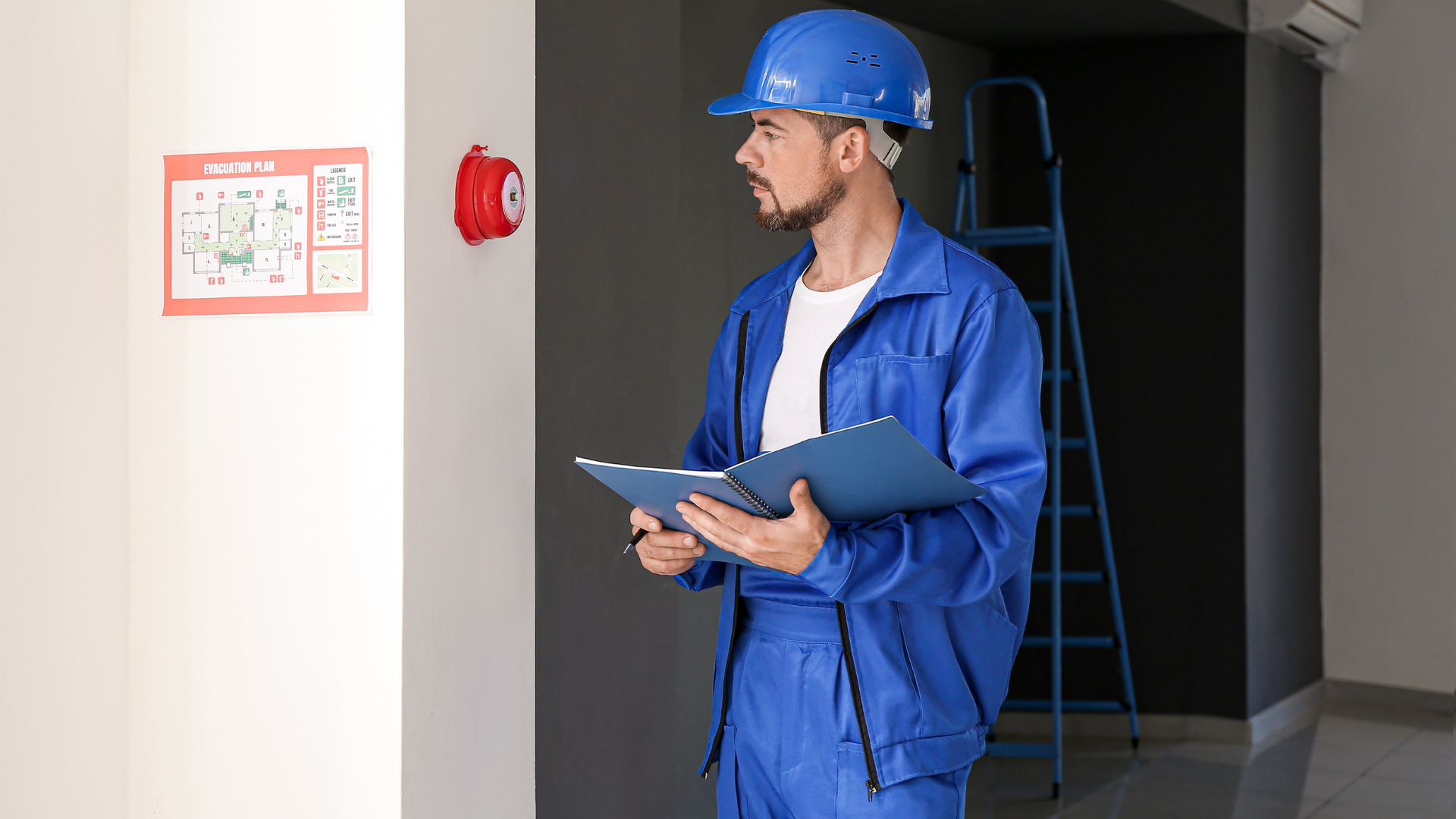Fire compartmentation (passive protection), often overshadowed by more active protection such as fire alarms and extinguishers, quietly ensures lives and properties are protected by halting fires’ swift propagation in buildings. The hidden hero prevents rapid spread and safeguards occupants, making it a vital fire safety component.
Did you know that the fire and rescue services attended 620,758 incidents in 2022 alone? While the dangers of fire are universally recognised, a significant number of buildings lack adequate compartmentation in the event of such a catastrophe.
Without proper compartmentation, a fire and smoke could rapidly consume the entire structure, risking numerous lives. With it, however, the spread of these and toxic gases can be effectively contained, granting crucial time for evacuation and firefighting efforts.
At BASSE Solutions, we realise the paramount importance of compartmentation fire safety. That’s why we’ve created this in-depth guide to highlight its crucial role in containing emergencies, safeguarding lives and complying with fire compartmentation regulations in the UK.
Whether you’re a facility / property manager responsible for ongoing safety protocols or a builder bringing new designs to life, read on to uncover the essential components that make fire compartmentation a cornerstone of modern safety practices.
Understanding Fire Compartmentation
What Is Fire Compartmentation
Defined by the Building Regulations Act 2010, fire compartmentation is a fundamental fire safety strategy employed in building design and construction. It refers to the practice of dividing a structure into separate compartments through the use of fire-resistant barriers, walls, floors and doors to contain the spread of flames, smoke and toxic gases to a limited area.
What Is The Main Objective Of Fire Compartmentation?
Commonly providing between 30 and 120 minutes of fire resistance, the main objective of a fire compartmentation plan is to prevent the rapid escalation of fire, and allow occupants more time to evacuate safely. It also supports effective fire fighting measures by containing the risk to individual zones.

Fire Compartmentation Regulations In The UK
The British standard for fire compartmentation stems from legislation in the Building Regulations Act 2010, the Fire Safety Act 2021 and the Building Safety Act 2022. Together, these regulations mandate fire-related materials for creating barriers engineered to withstand flame intensity and prevent their spread.
Specific construction methods are also prescribed, requiring careful assembly of fire-resistant walls, floors and ceilings to hinder the spread. Likewise, maintenance and inspection are ongoing priorities, with building owners and managers being responsible for ensuring barrier integrity and prompt repairs.
Non-compliance of fire regulations in the UK can have severe consequences. Therefore, it’s imperative that all stakeholders involved in the construction, operation and maintenance of buildings stay up-to-date with the ever-evolving fire safety guidelines.

Why Fire Compartmentation Matters
The Importance Of Fire Compartmentation In Buildings
Fire compartmentation encompasses three crucial roles – the safety of life, the protection of property and the safety of firefighters.
Safety Of Life
Fire compartmentation safety is required to protect your building’s most important aspect – its people. By establishing isolated compartments, it curbs the spread of fire, smoke and harmful gases, offering crucial time for occupants to evacuate to designated safe zones. It plays a pivotal role in securing safe escape routes, giving people a fighting chance at survival.
Property Protection
Fire compartmentation also stands as a protector of property. When fire ignites, it can cause substantial damage to both structure and contents, costing on average £657,074 per incident. However, fire compartmentation will constrain its expansion and mitigate its impact. By constraining flames to their origin, and preventing them from consuming other areas, fire compartmentation in buildings can limit devastation and reduce financial loss.
Firefighter Safety
Finally, a well-established fire compartmentation plan will significantly contribute to the wellbeing of firefighters. Well-defined fire compartments empower these specialists to anticipate fire behaviour and strategise their actions accordingly. Moreover, the confined nature of these compartments diminishes the risk of abrupt structural collapse, fostering a safer environment for firefighting crews in general.

What Are The Core Principles Of Fire Compartmentation?
At the core of your fire compartmentation plan should lay a key set of principles that form the foundation of a life-saving strategy. In accordance with the British standard for fire compartmentation, these principles must stem from legislation and ensure optimum fire safety.
Division & Separation
The first principle of any fire compartmentation plan should be division and separation. This involves the partition of a building into certain zones, shielded by fire-resistant barriers. These barriers, whether walls, floors or ceilings, should be engineered to withstand flames, smoke and heat, effectively confining the emergency to designated quarters and limiting the potential spread.
Fire Rated Construction Materials
The effectiveness of fire compartmentation relies on the strategic utilisation of fire-rated construction materials, meticulously crafted to endure extreme temperatures and curtail the fire’s advancement. When installed correctly, fire-rated gypsum boards, fire-resistant glass and fire doors can bolster the resilience and solidity of fire compartments, providing critical moments for evacuation and firefighting.
Fire Stopping & Sealing
To maintain the effectiveness of fire compartmentation in buildings, it’s essential to ensure proper fire sealing and stopping. Thwarting the passage of fire and smoke beyond the compartments, fire-resistant sealant around pipes, ducts and cables is pivotal in supporting barriers.
Integrity & Insulation
As stated in UK fire compartment regulations, fire-resistant barriers must remain structurally sound and limit heat transfer from one zone to another. This synergistic blend effectively restricts the fire’s trajectory, allowing any occupants to evacuate safely.
Egress Routes
Finally, the establishment of clear and safe egress routes for occupants to evacuate swiftly shouldn’t be overlooked. Well-planned evacuation paths are essential elements to consider alongside the core principles listed above.

Fire Compartmentation Services With BASSE
Building a fire compartmentation strategy isn’t straightforward. It requires hard work and understanding to ensure that architects, builders and facility managers work together to create a safe environment.
However, by leveraging the expertise of a third-party specialist like BASSE, you can feel safe in the knowledge that your strategy aligns with regulations to ensure the utmost safety for both residents and your building.
Professional Fire Compartmentation Contractors
At BASSE, our dedicated team of fire compartmentation contractors are well-versed in implementing essential fire safety measures. From the installation of fire-resistant doors to the precise placement of barriers and seals, our proficient team of fire compartmentation specialists ensure that every facet of the process is meticulously managed.
With our expertise, your building will be fortified with resilient safety measures that deliver both reassurance and protection for occupants in times of crisis.
Fire Compartmentation Services
As leading fire compartmentation specialists, our expert team provides a comprehensive strategy from cradle to grave. We’ll begin with diligent fire risk assessments to pinpoint vulnerabilities in your building’s fire safety, followed by a thorough compartmentation inspection of existing barriers, doors and components. Then, our dedicated team will promptly address any issues and implement upgrades to enhance safety measures.
Are your fire safety measures up to standard? Book a fire compartmentation survey with BASSE, and we’ll ensure that robust protection is provided for your building and its occupants. To get the ball rolling, contact our team today.






















